Peatland Fire Weather Conditions in Central Kalimantan, Indonesia
Abstract
1. Introduction
2. Materials and Methods
2.1. Study Area
2.2. Fire Hotspot (Hotspot) and Weather Data
2.3. Analysis Methods
3. Results
3.1. Fire Distribution
3.2. Fire Months and Rainfall
3.3. Average Dry and Fire Season
3.4. Various Fire Weather Conditions
3.4.1. Rainfall and Fire in 2015 and 2021
3.4.2. Weather Conditions in 2015 and 2021
- Diurnal change of temperature and humidity
- 2.
- Diurnal change of wind speed and direction
3.4.3. Diurnal Weather Conditions on Second HSs Peak Day
3.5. Various Fire Related Index
4. Discussion
4.1. Fire Distribution
4.2. Fire Months and Rainfall
4.3. Average Dry and Fire Season
4.4. Various Fire Weather Conditions
4.5. Various Fire Related Index
Author Contributions
Funding
Institutional Review Board Statement
Acknowledgments
Conflicts of Interest
References
- Langner, A.; Miettinen, J.; Siegert, F. Land cover change 20022005 in Borneo and the role of fire derived from MODIS imagery. Glob. Chang. Biol. 2007, 13, 2329–2340. [Google Scholar] [CrossRef]
- Hoscilo, A.; Page, S.E.; Tansey, K.J.; Rieley, J.O. Effect of repeated fires on land-cover change on peatland in southern Central Kalimantan, Indonesia, from 1973 to 2005. Int. J. Wildland Fire 2011, 20, 578–588. [Google Scholar] [CrossRef]
- Miettinen, J.; Shi, C.; Liew, S.C. Deforestation rates in insular Southeast Asia between 2000 and 2010. Glob. Chang. Biol. 2011, 17, 2261–2270. [Google Scholar] [CrossRef]
- Hooijer, A.; Page, S.; Jauhiainen, J.; Lee, W.A.; Lu, X.X.; Idris, A.; Anshari, G. Subsidence and carbon loss in drained tropical peatlands. Biogeosciences 2012, 9, 1053–1071. [Google Scholar] [CrossRef]
- Page, S.E.; Rieley, J.O.; Banks, C.J. Global and regional importance of the tropical peatland carbon pool. Glob. Chang. Biol. 2011, 17, 798–818. [Google Scholar] [CrossRef]
- Dargie, G.C.; Lewis, S.L.; Lawson, I.T.; Mitchard, E.T.A.; Page, S.E.; Bocko, Y.E.; Ifo, S.A. Age, extent and carbon storage of the central Congo Basin peatland complex. Nature 2017, 542, 86–90. [Google Scholar] [CrossRef] [PubMed]
- Rieley, J. Mega Rice Project (MRP) Central Kalimantan. Available online: https://peatlands.org/is-indonesia-heading-for-another-mega-rice-project-disaster/ (accessed on 11 March 2023).
- IPCC. 2022: Summary for Policymakers. In Climate Change 2022: Impacts, Adaptation and Vulnerability. Contribution of Working Group II to the Sixth Assessment Report of the Intergovernmental Panel on Climate Change; Pörtner, H.-O., Roberts, D.C., Tignor, M., Poloczanska, E.S., Mintenbeck, K., Alegría, A., Craig, M., Langsdorf, S., Löschke, S., Möller, V., et al., Eds.; Cambridge University Press: Cambridge, UK; New York, NY, USA, 2022; pp. 3–33. [Google Scholar]
- Oktaviani, R.; Amaliah, S.; Ringler, C.; Rosegrant, M.W.; Sulser, T.B. The Impact of Global Climate Change on the Indonesian Economy; IFPRI Discussion Paper 1148; International Food Policy Research Institute: Washington, DC, USA, 2011; Available online: http://ebrary.ifpri.org/cdm/ref/collection/p15738coll2/id/126762 (accessed on 11 March 2023).
- WBG Climate Change Knowledge Portal (CCKP, 2021). Available online: https://climateknowledgeportal.worldbank.org/country/indonesia/climate-data-historical (accessed on 2 April 2023).
- Aldrian, E. Decreasing Trends in Annual Rainfalls over Indonesia: A Threat for the National Water Resource? Geophysics and Meteorology Agency, Jakarta, Indonesia. 2007. Available online: https://www.researchgate.net/publication/284944836_Decreasing_trends_in_annual_rainfalls_over_Indonesia_A_threat_for_the_national_water_resource (accessed on 11 March 2023).
- Wang, B.; Luo, X.; Yang, Y.-M.; Sun, W.; Cane, M.A.; Cai, W.; Yeh, S.-W.; Liu, J. Historical change of El Niño properties sheds light on future changes of extreme El Niño. Proc. Natl. Acad. Sci. USA 2019, 116, 22512–22517. [Google Scholar] [CrossRef] [PubMed]
- Sulaiman, A.; Osaki, M.; Takahashi, H.; Yamanaka, M.D.; Susanto, R.D.; Shimada, S.; Kimura, K.; Hirano, T.; Wetadewi, R.I.; Sisva, S.; et al. Peatland Groundwater Level in the Indonesian Maritime Continent as an Alert for El Niño and Moderate Positive Indian Ocean Dipole Events. Sci. Rep. 2023, 13, 939. [Google Scholar] [CrossRef] [PubMed]
- Hayasaka, H.; Usup, A.; Naito, D. New Approach Evaluating Peatland Fires in Indonesian Factors. Remote Sens. 2020, 12, 2055. [Google Scholar] [CrossRef]
- Hayasakaand, H.; Putra, E.I. Reassessment of Peatland Fires in Central Kalimantan. In IOP Conference Series: Earth and Environmental Science; IOP Publishing: Bristol, UK, 2022; Volume 959. [Google Scholar] [CrossRef]
- Liebmann, B.; Marengo, J.A.; Glick, J.D.; Kousky, V.E.; Wainer, I.C.; Massambani, O. A Comparison of Rainfall, Outgoing Longwave Radiation, and Divergence over the Amazon Basin. J. Clim. 1998, 11, 2898–2909. [Google Scholar] [CrossRef]
- Lim, E.S.; Wong, C.J.; Abdullah, K.; Poon, W.K. Relationship between outgoing longwave radiation and rainfall in South East Asia by using NOAA and TRMM satellite. In Proceedings of the 2011 IEEE Colloquium on Humanities, Science and Engineering, Penang, Malaysia, 5–6 December 2011. [Google Scholar] [CrossRef]

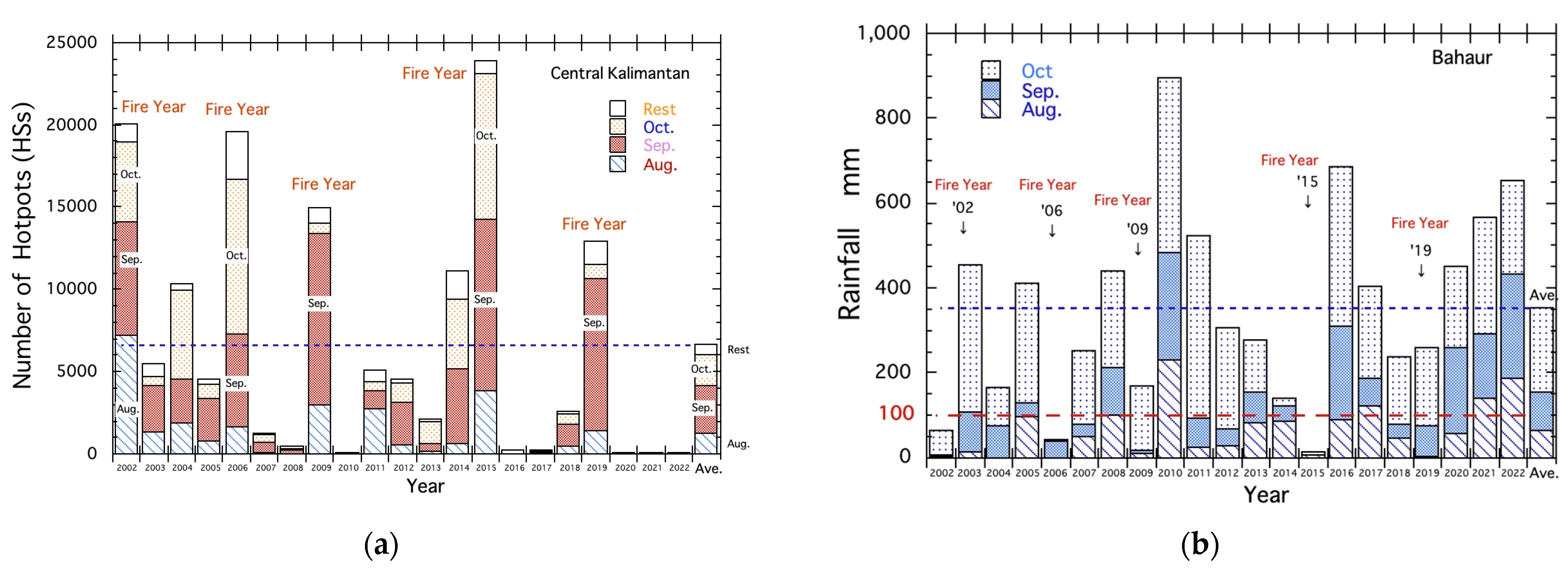
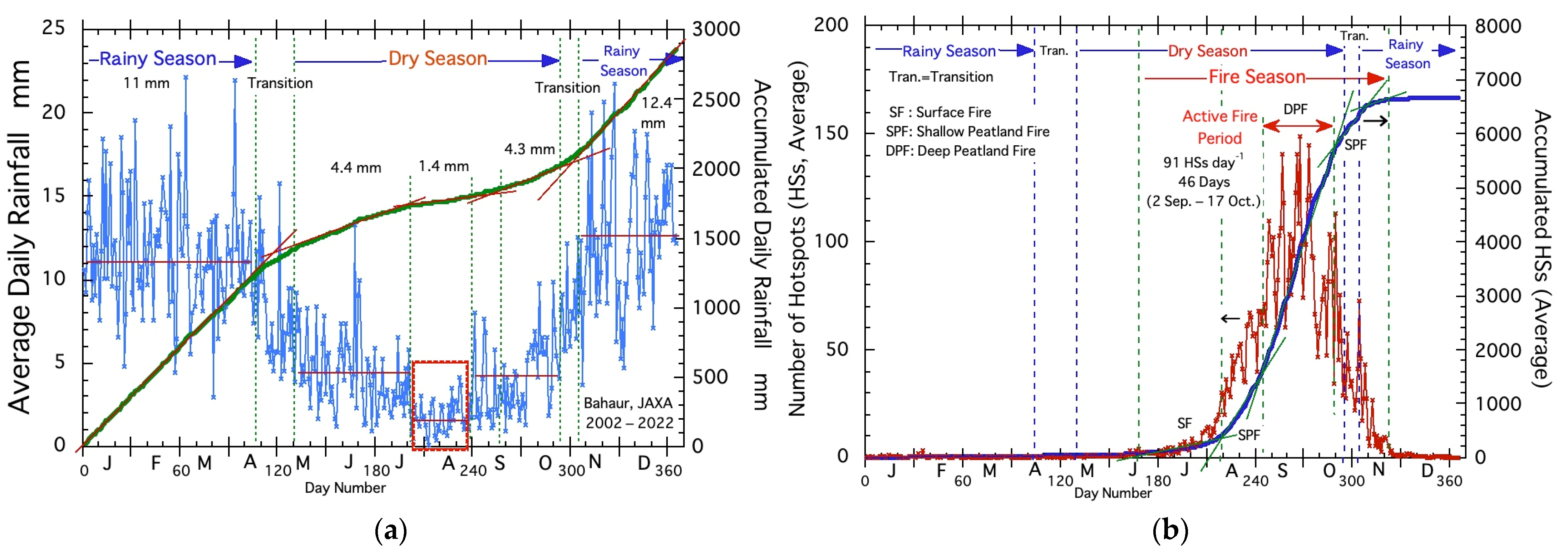
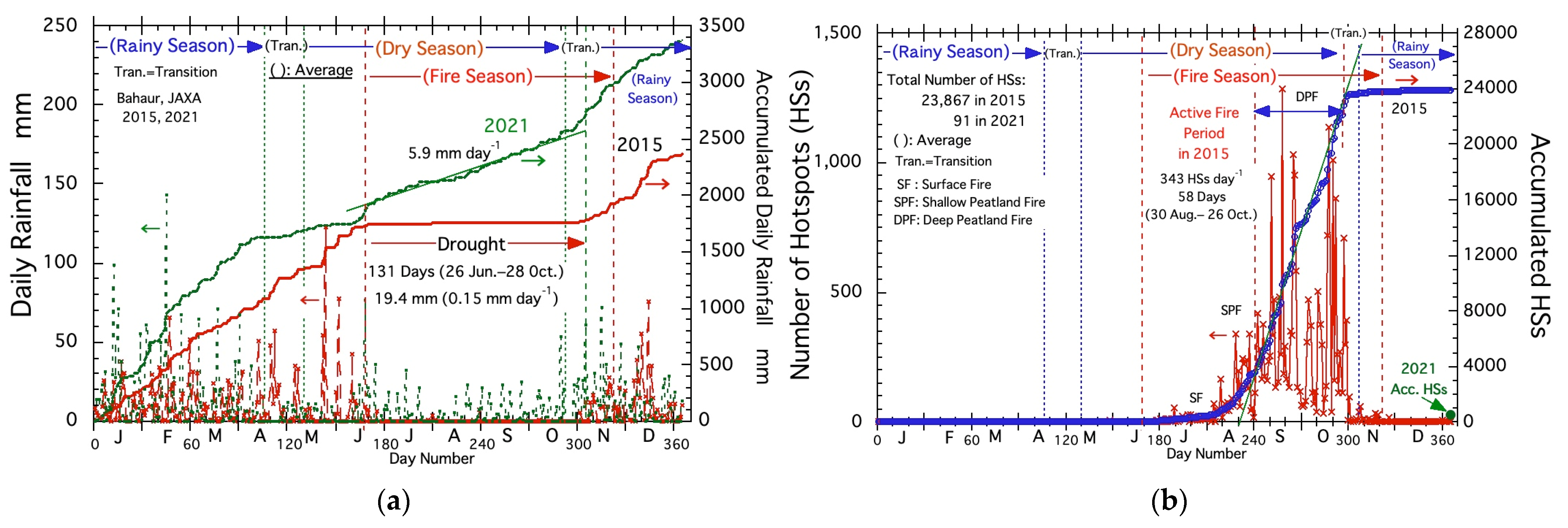

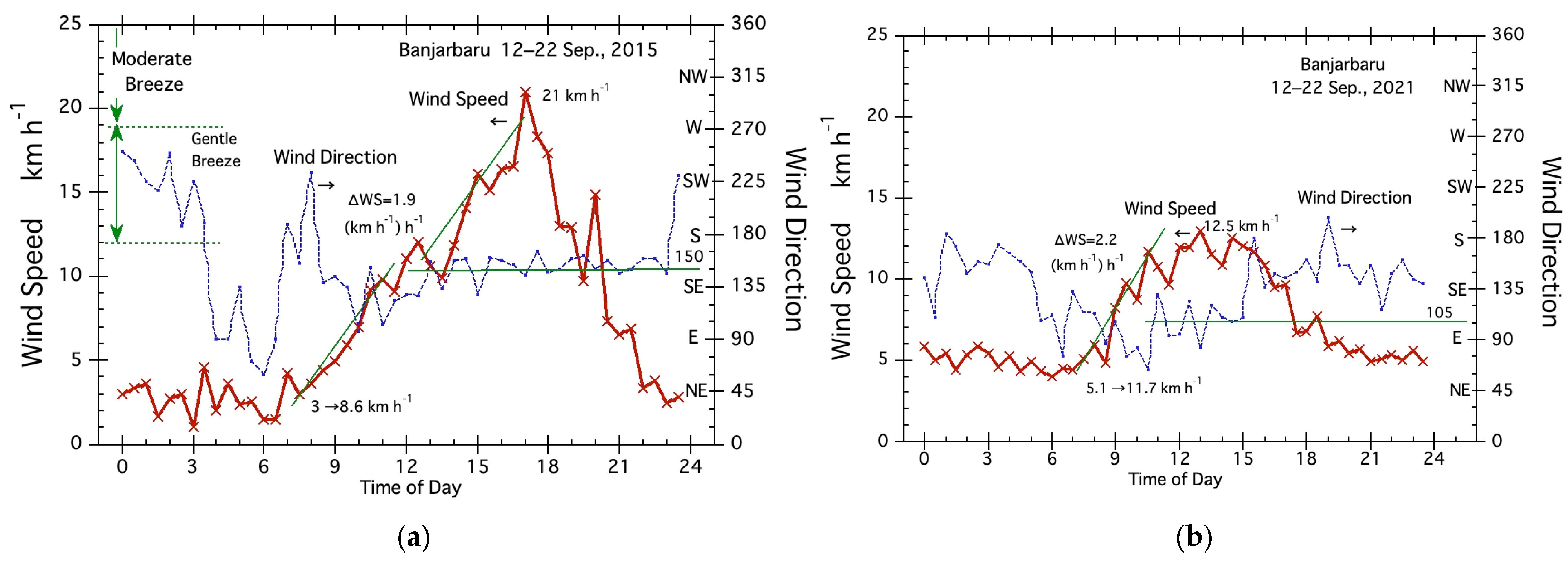
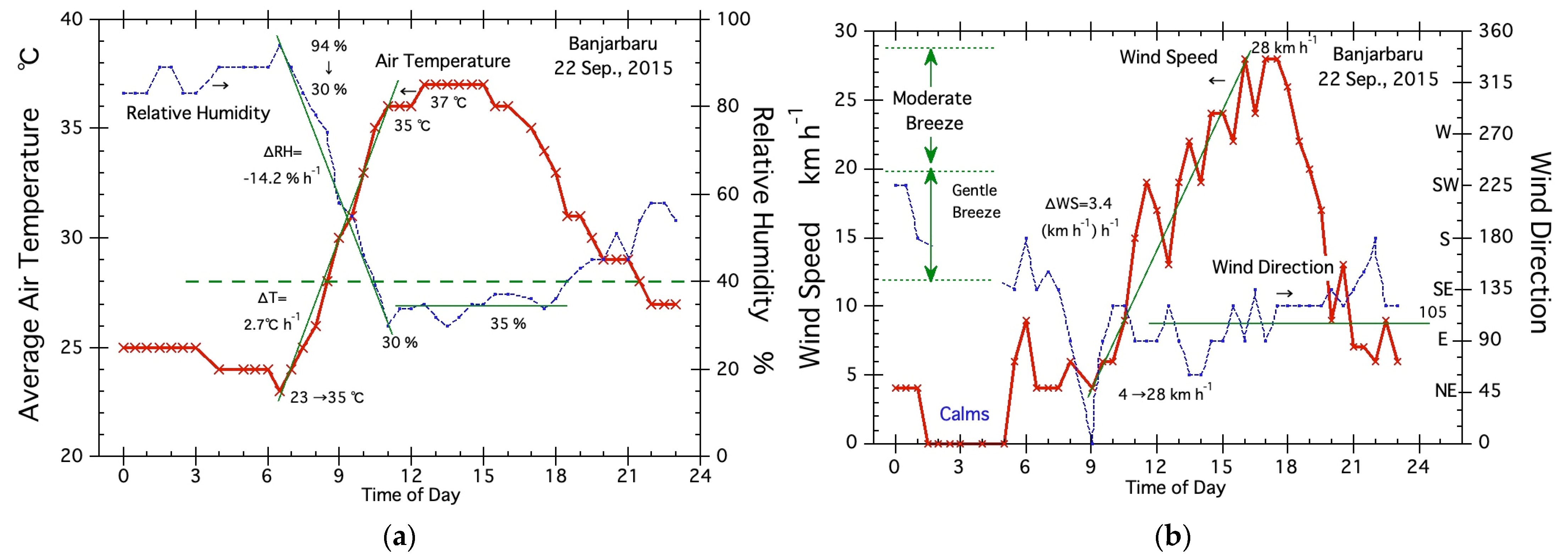
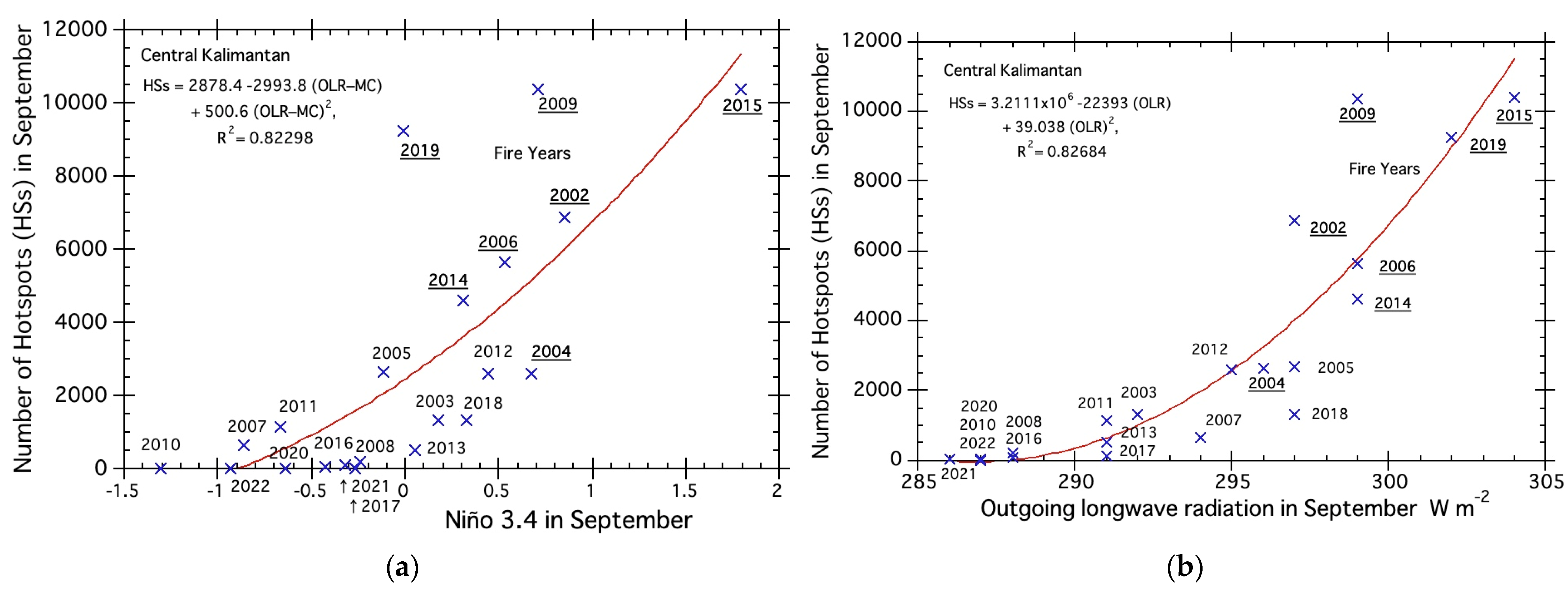
| Date, Month, Year | Temperature | RH | Wind Speed | Wind Direction Change | Remarks | |||
|---|---|---|---|---|---|---|---|---|
| Highest | ΔT | Lowest | ΔRH | Highest | ΔWS | |||
| 12–22 September 2015 | 36.0 | 2.7 | 37.0 | −12.6 | 21.0 | 1.9 | (S)→SE | Figure 5a and Figure 6a |
| 12–22 September 2021 | 31.1 | 1.6 | 45.8 | −8.0 | 12.5 | 2.2 | SE→E | Figure 5b and Figure 6b |
| Difference | 4.9 | 1.1 | −8.8 | −4.6 | 8.5 | −0.3 | ||
| 12 September 2015 | 37.0 | 2.7 | 30.0 | 14.2 | 28.0 | 3.4 | (SE)→E | Figure 7a,b |
Disclaimer/Publisher’s Note: The statements, opinions and data contained in all publications are solely those of the individual author(s) and contributor(s) and not of MDPI and/or the editor(s). MDPI and/or the editor(s) disclaim responsibility for any injury to people or property resulting from any ideas, methods, instructions or products referred to in the content. |
© 2023 by the authors. Licensee MDPI, Basel, Switzerland. This article is an open access article distributed under the terms and conditions of the Creative Commons Attribution (CC BY) license (https://creativecommons.org/licenses/by/4.0/).
Share and Cite
Usup, A.; Hayasaka, H. Peatland Fire Weather Conditions in Central Kalimantan, Indonesia. Fire 2023, 6, 182. https://doi.org/10.3390/fire6050182
Usup A, Hayasaka H. Peatland Fire Weather Conditions in Central Kalimantan, Indonesia. Fire. 2023; 6(5):182. https://doi.org/10.3390/fire6050182
Chicago/Turabian StyleUsup, Aswin, and Hiroshi Hayasaka. 2023. "Peatland Fire Weather Conditions in Central Kalimantan, Indonesia" Fire 6, no. 5: 182. https://doi.org/10.3390/fire6050182
APA StyleUsup, A., & Hayasaka, H. (2023). Peatland Fire Weather Conditions in Central Kalimantan, Indonesia. Fire, 6(5), 182. https://doi.org/10.3390/fire6050182











